|
The Great Lakes Irish Invaders
Being old does have certain benefits

Tie in the aft
hackle facing forward, epoxy the thread winding and let dry
I'm
old. Very old. 75 to be exact. But being old does have
certain benefits a lot of younger people aren't privy to. I
can be as eccentric as I want without any incriminatory blow
back from those still searching for a place to call their
own. However, advanced age does have a down side, many of my
friends seem to think I'm too old to get into trouble and
conspire to keep me locked down in a safe mode. One of those
misguided is my friend, Stuart Anderson, who owns the
Canadian Tube Fly Company and sends me tying supplies.
As he puts it, "to keep me out of the bars and out of
trouble".
His latest care
package was filled with tubes which he started manufacturing
from a lighter alloy to appease North American Steelheaders
who complained about the heavy weight of similar European
tubes. Among the tubes were some interesting tapered shrimp
tubes in 1/2 and 1 inch sizes, anodized in silver, gold and
black. At first glance the tubes appeared to be of tubes
more common to Europe especially the United Kingdom instead
of what we see here in North America. I wrote to my old
friend Arthur in Northern Ireland and told him I would tie
him up some Irish shrimp patterns on tubes and he accepted
the offer.
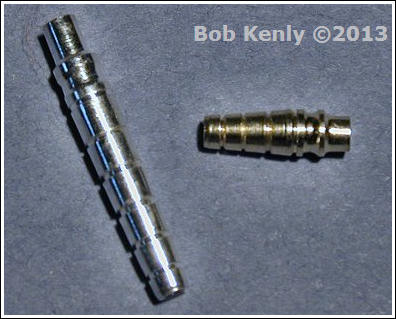
Stuart's tubes
Irish Shrimp
flies
Irish shrimp flies
tend to be very different than what we normally see in North
America, however they are popular with West Coast Steelhead
fishers. The fly construction generally follows a long held
Irish tradition of construction, anywhere in size from #16
to #2/0, tied on treble or double hooks with some of the
larger sizes in single hooks. The body of the fly is usually
divided in two separate colors. At the eye end there is
usually a hackle that extends in a cone toward the tail end
of the fly. To simulate the shrimp's eyes Jungle Cock nails
are placed under the forward hackle although there are some
Irish shrimp patterns that have the JC at the middle
hackles. The middle hackle is generally tied at the division
point between the two body colors. again in a cone shape
facing toward the tail (or aft if you insist) of the fly.
The tail of the fly is generally made of GP feathers from
Golden pheasant tied so the tail is splayed out from the
centerline of the hook.
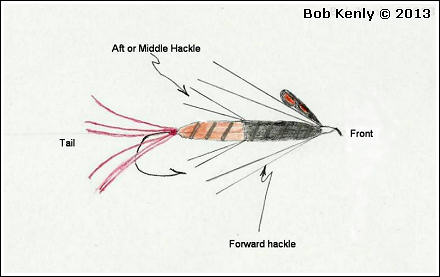
The anatomy of
the traditional Irish fly
Robert Gilliespie wrote
a comprehensive piece about tying the tails on Irish flies.
Like everything else in fly tying these rules shouldn't be
considered written stone. For one reason or another the
Irish seem to shun tube flies, however you are starting to
see some traditional shrimp hook patterns tied in tubes,
albeit my interpretation is different from the original.
Ireland and the
Great Lakes Connection
After tying some Irish
styled patterns for my friends in Northern Ireland I came to
my "What Now Period", remembering a conversation I had with
an Irish friend who told me Irish shrimp flies were used in
Western North America for Steelhead. Since I'm unable to
travel far to try out my creations my usual plan is to find
someone willing and able enough to take my patterns
swimming, sort of standing on a virtual street corner with a
sign around my neck stating, "Broken down old man needs
someone to try his flies". Almost as quick as it was posted
I got an answer from Chris, a young man from Ontario,
Canada. The big surprise came when he said that he fished
for Steelhead in the Great Lakes tributaries using Irish
Shrimp flies. I have fished the Great Lakes tributaries many
times and never even seen any shrimp flies being used or
sold, in fact except for the fresh water Mysis shrimp I
didn't think the Great Lakes, being fresh water, had any
shrimp at all. Before I got accused of being stuck in stupid
I thought it wise I'd better make sure I knew what I was
talking about before making a bunch of rash statements. It
seems there are a large amount of shrimp in the Great Lakes,
small 1/2 inch, fat rich, bright orange and white colored
that came from ballast on ships that plied their trade from
the Black and Caspian seas. The infestation reached from
Ontario on the Canadian side to Michigan on the American
side and its expected that Hemimysis Anomala will soon be a
major problem in the food chain if not already. Chris was
looking for an orange colored pattern so I cobbled him up
something I thought might be of interest to the Great Lakes
Steelhead.
Chris's Shrimp, Great Lakes Orange
Heads or Tails: So
as not to overly confuse the situation regarding which is
the fly's front and which is the back I'd probably better
explain my thinking (such as it is at 75). The Irish call
the eye end of the hook the "Front" and the end with the
hook the "aft" part of the fly. Then of course what comes
out the back is the tail. I've had many lively discussions
as to why it's that way, such as why the shrimp eyes are at
the tail of a normally swimming shrimp on Irish flies. My
thinking is the end with the head of the shrimp (the eyes
being on the head) is the front and what sticks out from the
head are the feelers, totally opposite from Irish thinking.
Normally shrimp swim backwards, tail first, thus my way of
orientation on shrimp flies as to what is front and what is
back.
Tube: Stuart
Anderson's 12 mm shrimp tube
Thread: Orange 8/0 or finer
Eyes: Epoxy eyes, painted black. made on 2 pound test
mono
Feelers: Very mobile hair such as Arctic fox
Flash: two pieces of Krystal Flash
Front Hackle: Chinese hackle Aft
Hackle: Schlappen
Epoxy: Devcon 2-Ton
Epoxy
Since I'm under no
time constraints when I tie I always use Devcon epoxy but if
I were tying a lot of flies I would consider using one of
the new generation of instant drying epoxies which use a
light source to harden the epoxy.
Eyes
I absolutely shun
the use of Jungle Cock nails on my flies especially shrimp
flies. All of my shrimp have epoxy eyes where the head would
normally be when swimming. Before doing anything else I take
a short piece of two pound test mono and burn a knot in each
end with a lighter. Then I make a small puddle of Devcon
5-minute epoxy and keep dipping the knots in the epoxy till
a ball forms. After the eye has dried I color each eye with
acrylic artist's paint in a contrasting color to the fly.
After the paint is dry I cover the eyes with Devcon 2-Ton
epoxy to protect them.

Color the tube
with the desired color
Tubes
The tube I use is
Stuart Anderson's 12mm shrimp tubes. These are uncolored and
do not have a liner installed however Stuart does send
plenty of liner material with the tubes. (pic: Stuarts
Tubes) One thing I found very helpful I always cement my
liners in the tubes with epoxy to keep them from turning
while tying on them. My next step is to color the tube with
the desired color (In my article I'll do
a comprehensive dissertation on coloring raw tubes).
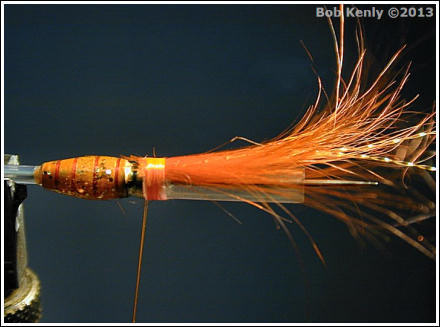
Tie the
feelers and flash directly on the hook keeper
Attaching the
feelers
I tie the feelers
and flash directly on the hook keeper.
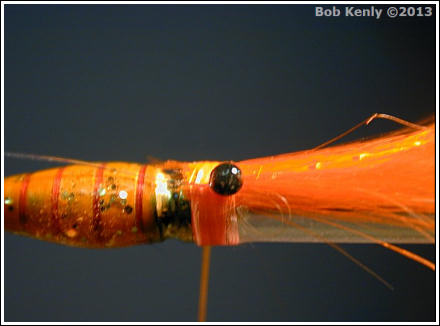
Attach the
eyes right on the head
Attaching the
eyes
Attach the eyes
right on the head right after you tie on the feelers. I tie
in the eyes catching the mono with the thread and cutting
the excess mono off. Now attach the other eye on the
opposite side of the head Next I epoxy the threaded head
area, flow epoxy under the eyes to prevent them from being
torn off. Let the epoxy dry and cure, preferably overnight.

Epoxy the
threaded head area, flow epoxy under the eyes to prevent
them from being torn off
Front hackle
Tie in the front
hackle, I fold the hackle and tie in in facing forward, I
also cut off the top barbs of the hackle so that the eyes
show more predominately when the fly is finished. Epoxy the
thread windings and let dry.

Tie in facing
forward, and cut off the top barbs of the hackle so that the
eyes show more predominately
Aft hackle
Tie in the aft
hackle facing forward, epoxy the thread winding and let dry.
Snip off the excess tubing and the fly is ready to use
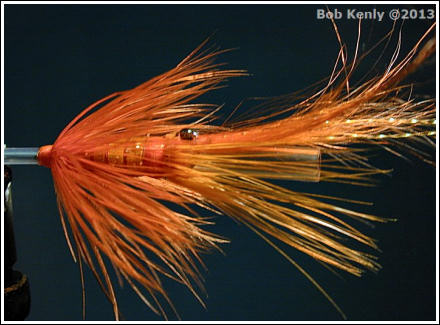
Tie in the aft
hackle facing forward, epoxy the thread winding and let dry
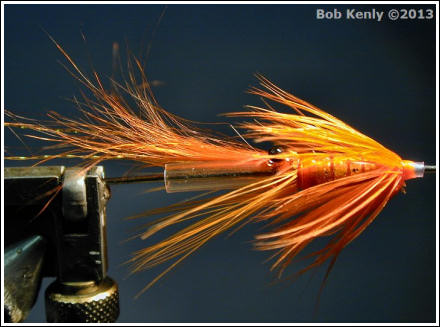
Snip off the
excess tubing and the fly is ready to use
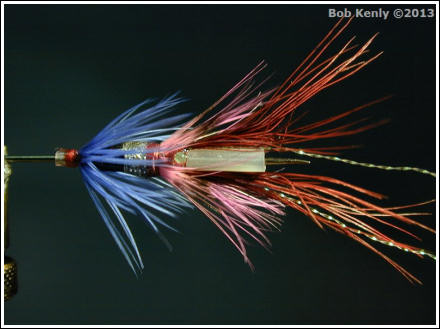
Irish-American
Wilkinson
Some Final
Thoughts
It's easy to see
that Chris's Shrimp can't be considered a pure Irish Shrimp
fly as I took a little of this and that from other patterns
to meld what I thought would make a nice Steelhead fly. When
the fly arrived Chris immediately too it to a local river
and caught several resident Steelhead plus a Smallmouth bass
of all things. So now we're faced with the question whether
Great Lakes fish recognize shrimp patterns as shrimp,
something good to eat, or do they just like the flies
because they like the colors and the fact they wiggle in the
water. I've tied Chris several other patterns which may
possibly answer that question in the future.
So what's next for me,
maybe South America, Argentina or Chile perhaps (I'm
somewhat partial to their cuisine). So if there is someone
down there who would like to try some of my shrimp patterns
give me a shout and we can discuss the matter.
By Bob Kenly 2010 ©
Bob's
website |